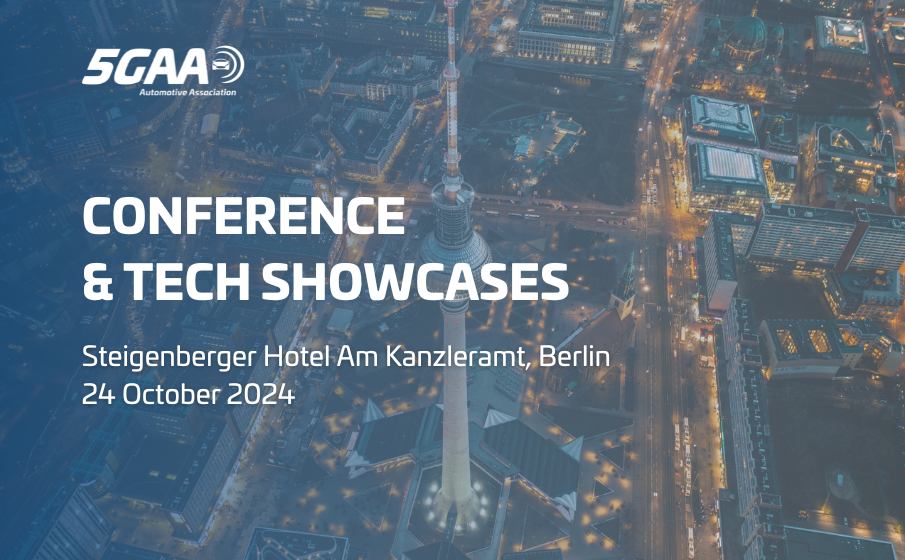
5GAA Members to Demonstrate Latest C-V2X Tech in Berlin
The 5G Automotive Association (5GAA) will host a technology demonstration event in Berlin on 24 October, showcasing the potential of Cellular Vehicle-to-Everything (C-V2X) technology to redefine mobility across Europe. The event will take place with 5GAA members, leaders from the automotive, telecommunications and technology sectors; it will feature over 10 indoor and outdoor demonstrations that address both critical safety and advanced applications.
C-V2X leverages cellular networks to connect vehicles with each other, infrastructure, and pedestrians, aiming to enhance safety and convenience on the roads. This technology has gained momentum globally, with favourable legislative frameworks in Europe, the U.S. and beyond, and commitment from automakers. This signifies a robust ecosystem that is ready to leverage a huge amount of already existing connected vehicles and deploying further C-V2X solutions at scale.
In countries like Germany, traffic accidents remain a significant concern, with the country alone recording 2.5 million incidents in 2023 and pedestrian safety a growing issue. It is also estimated that up to 40% of traffic in German urban centres stems from drivers searching for parking. C-V2X is positioned to address these challenges.
The Berlin demo event will build upon the 5GAA demonstrations held last year in Detroit, which revolved around vulnerable road user protection. This year, the focus will shift to showcasing similar and new use cases in a European environment, utilising existing European mobile infrastructure.
The event will be preceded by the 5GAA conference titled “Scaling Up Connected Mobility: What’s Next for Germany and Europe?” This combined event offers a unique platform for attendees to engage with industry leaders and stakeholders.
Registration and Media Inquiries:
For further information and registration, please contact secretariat@5gaa.org.
Journalists interested in attending can reach out to marcom@5gaa.org.
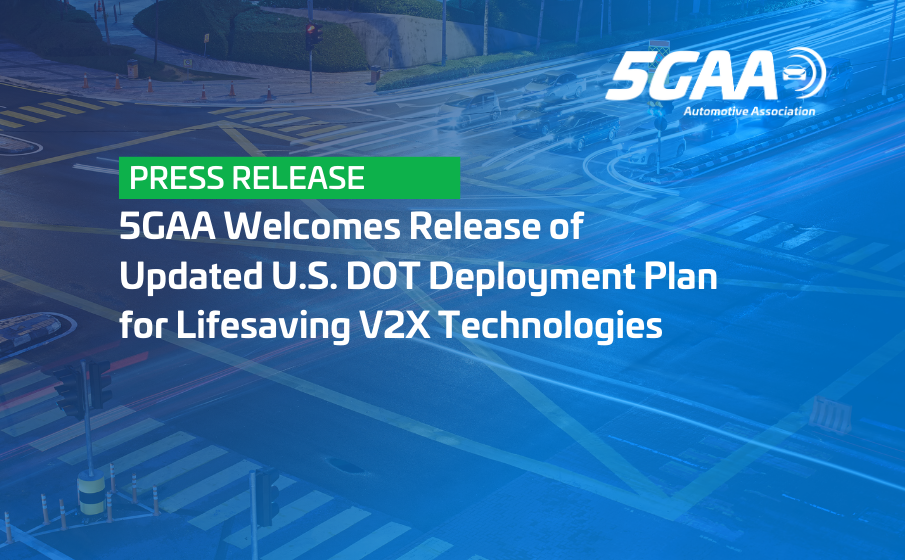
5GAA Welcomes Release of Updated U.S. DOT Deployment Plan for Lifesaving V2X Technologies
WASHINGTON, D.C., August 16, 2024 – The 5G Automotive Association (5GAA) welcomes the publication of the U.S. Department of Transportation’s updated V2X Deployment Plan and USDOT’s continuing commitment to the deployment of vehicle-to-everything (V2X) communications technologies on America’s roads.
The National V2X Deployment Plan outlines USDOT’s vision and specific milestones for the deployment of V2X. Cellular-vehicle-to-everything (C-V2X) technology allows cars, trucks and other vehicles to send important safety alerts with one another, with road infrastructure and with vulnerable road users securely and in real-time, with two complementary transmission modes (direct and mobile network communications).
“Today’s release establishes clear objectives for future public and private investments in V2X in U.S. road transportation networks,” said John F. Kwant, Executive Director, Americas, for 5GAA. “V2X technologies are key to enabling the deployment of connected motor vehicles and roadside infrastructure that can sharply reduce road fatalities, a key goal of the National Road Safety Strategy. “
Unlocking the full potential of V2X technologies requires as many road users, traffic signals and other traffic infrastructure as possible to be able to seamlessly communicate with one another and share information with a broader network. 5GAA believes that this requires the deployment to be nationwide, secure and interoperable, provide solutions for existing vehicles as well as new vehicles, and include interfaces for both C-V2X direct and network communications modes (cellular and non-terrestrial networks).
About 5GAA
The 5G Automotive Association (5GAA) is a global, cross-industry organization of over 120 members, including leading global automakers, Tier-1 suppliers, mobile operators, semiconductor companies, and test equipment vendors. 5GAA members work together to develop end-to-end solutions for future mobility and transport services. 5GAA is committed to helping define and develop the next generation of connected mobility, automated vehicle, and intelligent transport solutions based on C-V2X.
For more information, please contact:
- John Kwant: john.kwant@5gaa.org
- 5GAA Communications Team: marcom@5gaa.org

Meet Our Members – Interview with Menno Malta, Monotch CEO
The 5G Automotive Association (5GAA) thrives on the collective expertise and collaborative spirit of its members. Over 110 organisations strong, our membership represents a global network of market leaders and innovators shaping the future of connected mobility.
We are kicking off a new series, “Meet Our Members,” to delve deeper into the stories of the individuals who make up the backbone of 5GAA. First up, we will be featuring Menno Malta, CEO of Monotch, who has been actively involved in one of 5GAA’s most recent and exciting areas of work – Vehicle-to-Network-to-Everything (V2N2X) communication.
This interview series will showcase a diverse range of profiles, highlighting their contributions, challenges, and predictions for the exciting world of 5G-connected transportation. Get ready to be inspired by the passion and ingenuity of our members as we meet the people who make 5GAA.
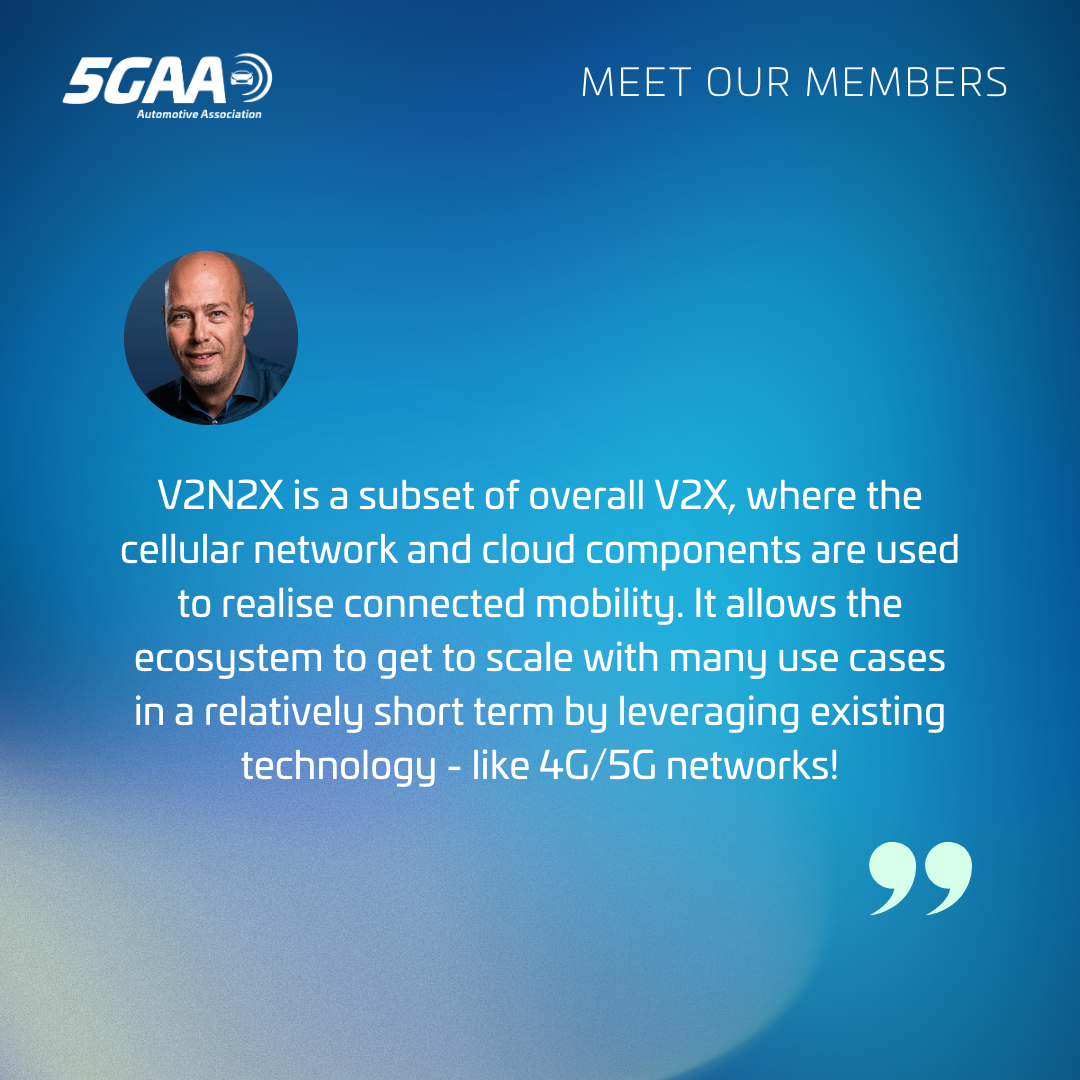
Menno, you are the CEO of Monotch, a 5GAA member company. How does Monotch’s work relate to 5GAA’s, and what keeps you engaged with our association?
Monotch operates at the forefront of the V2N2X market. Our proven TLEX platform is used by cities and road authorities all over the world to connect mobility and digital infrastructure bringing substantial societal benefits and increased cost-effectiveness.
The initial interest that drew us to 5GAA was the opportunity to engage with OEMs, mobile network operators, and related industries. This is still of interest! We really appreciate the possibilities to discuss developments and work jointly on progressing the market. The networking opportunities are also great for us.
Monotch is based in the Netherlands. Last year, your views were instrumental in the organisation of 5GAA’s workshop in the Hague, where we looked at C-V2X deployment in the Low Countries. Two years later, what is the state of play for C-V2X and connected mobility in the Netherlands, and how do you see it unfolding?
In the Netherlands, we see a steady growth of smart and connected roadside infrastructure as well as new use cases such as emergency vehicle warnings that are now available on a large scale. This leads to more connected parties, including the first vehicle OEMs. On top of this, there is a push on urban challenges and use cases, which will lead to even more data and impact in the next few years. The Netherlands is truly a lighthouse deployment, and authorities from other countries come here often to see what’s happening and how they can apply learnings in their own jurisdiction.
One of 5GAA’s recent areas of work has been vehicle-to-network-to-everything (V2N2X) communications, and you’ve been one of its main contributors. What is V2N2X, what makes this such an important topic, and what are some of the biggest hurdles to overcome in achieving its widespread adoption?
V2N2X is a subset of overall V2X, where the cellular network and cloud components are used to realise connected mobility. It allows the ecosystem to get to scale with many use cases in a relatively short term, as it leverages existing technology such as apps, onboard units and, of course, the 4G/5G network! I think it’s hugely important for 5GAA as it shows the value of a connected ecosystem to the main stakeholders and can kickstart overall C-V2X deployment.
The V2N2X work item has been concluded with the publication of a white paper, ‘Road Traffic Operation in a Digital Age,’ and two associated reports. What is the objective of these publications, and how do they complement each other?
The white paper can be seen as a summary of the Technical V2N2X Architecture report. It’s a great read for everyone involved in this market, whether you’re an authority or a private sector executive. The Technical V2N2X Architecture report offers detailed insights into the blueprint architecture, and I recommend it to subject matter experts.
The other technical report is of a different nature. It describes the V2N2X market from a business perspective—for example, the market size, the kinds of business models we see, and which factors drive the market. It also contains descriptions of large-scale example deployments, taking away whatever doubts people might have about the feasibility of V2N2X..
The upcoming online session on 18 June will present the findings of these publications. What are you most excited about sharing with the audience?
So much to share! I can promise the session will be packed with insights, but I’m probably most excited to share the OEM and IOO (Infrastructure Owner and Operator) customer profiles we created. It’s about their goals, pains and gains, and for this, we did a survey and an analysis of large-scale deployments. I’m so excited about it because it really ties to the why of our work.

ADAS and Autonomous Vehicle Technology Expo: 5G Automotive Connectivity – What to Expect and When
5GAA Chief Technology Officer Maxime Flament is in Stuttgart today to present on ‘5G Automotive Connectivity: What to expect and when’ at this year’s ADAS and Autonomous Vehicle Technology Expo.
Taking place from 09:25-9:50, Maxime gave attendees an overview of the 5GAA roadmap ramping up toward increasingly advanced use cases in the 2030 timeframe, while also touching on the importance of the full integration of V2X technology into ADAS and automated driving systems (ADS).
Find the 5GAA 2030 Roadmap here.
Among other things, Maxime explained to attendees how:
- Many safety and traffic V2X use cases are emerging, from simple hazard warnings to teleoperation gradually increasing levels of complexity and automation
- The 5GAA roadmap envisions a rapid integration of V2X into ADAS and ADS
- Automotive connectivity exploits different radio access: vehicle-to-network, vehicle-to-vehicle, vehicle-to-roadside and vehicle-to-satellite
- Recent progress has been demonstrated in accurate positioning, low-latency services using MEC, 5G-compliant satcom, pedestrian and cyclist protection, etc
- Auto manufacturers are focussing on 5G 3GPP standards
Maxime also had the chance to meet with 5GAA members exhibiting their innovative 5G-V2X solutions at the event.
The ADAS and Autonomous Vehicle Technology Expo is one of the world’s biggest conferences focused on ADAS and assisted driving and is not to be missed for anyone with an interest in connectivity and connected mobility.
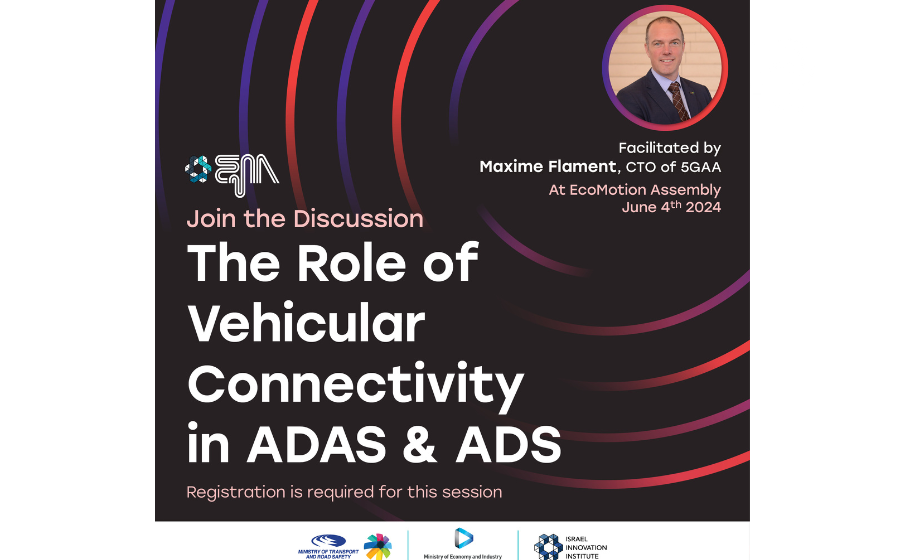
EcoMotion Assembly 2024: The Role of Vehicular Connectivity in ADAS and ADS
5GAA Chief Technology Officer Maxime Flament will be in Rosh Haayin, Israel, on 4 June to lead a workshop on vehicular connectivity in advanced driving and automated driving systems at this year’s EcoMotion Assembly.
Taking place from 11:30 – 12:30, the workshop, ‘The Role of Vehicular Connectivity in Advanced Driving Systems and Automated Driving Systems’, will see 5GAA members and community partners alike take part in an interactive discussion of how seamless vehicle-to-everything (V2X) communication fosters safer, smarter and more efficient transportation.
Participants will have the opportunity to learn about the integration of real-time data exchange between vehicles and other road users, which is instrumental in predicting and mitigating potential hazards and thereby significantly reducing the likelihood of accidents.
Speakers will highlight a number of cutting-edge technologies with an emphasis on their role in enhancing situational awareness and the decision-making capabilities of automated vehicles. This will include:
- 5G-V2X direct edge computing
- Software-defined vehicles
- Artificial intelligence
Don’t miss out on your chance to join the discussion with industry leaders!
For more details and contact info to sign up for the discussion, visit https://www.ecomotionweek.com/workshop-discussions.
All participants must be registered for the main event – use the 5GAA discount code EMA245gaa : https://ecomotion-assembly.forms-wizard.biz/.

5GAA’s John Kwant Explores the Current C-V2X Regulatory Landscape in the United States at the OmniAir Plugfest
5G Automotive Association (5GAA) Executive Director, Americas John Kwant is in Ann Arbor, Michigan today to explore the current regulatory landscape for C-V2X deployment in the United States as part of a panel on connected mobility at today’s OmniAir Plugfest.
Speaking at 9:00 (UTC-4) in the panel ‘Accelerating V2X Deployment: Bridging Government Initiatives, Industry Readiness and Local Implementations’, John Kwant will bring his expertise to the table and address the state of regulation and legislation covering V2X technology in the United States, as well as explain 5GAA’s work to promote deployment and widespread technology adoption.
The OmniAir Plugfest is an annual event hosted at MCity, Michigan in partnership with the University of Michigan Transportation Research Institute. It is the world’s first purpose-built proving ground for testing the performance and safety of connected and automated vehicles and technologies under controlled and realistic conditions.
Today’s Connected Mobility Workshop offers a one-day technical deep dive into topics related to deployment, testing and future trends, along with live technology demonstrations and a networking reception.
In addition to 5GAA’s participation, attendees will have the opportunity to hear the insights of a number of experts and stakeholders including:
- John Harding, Federal Highway Administration
- Brian Romansky, INTEGRITY Security Services
- Debra Bezzina, University of Michigan Transportation Research Institute
5GAA Statement of Support for OmniAir Consortium
5GAA also wishes to express the association’s support for OmniAir Consortium’s C-V2X certification programme and appreciation for OmniAir C-V2X initiatives generally.
OmniAir Consortium’s certification programme, first established in 2021, is of significant benefit to the entire C-V2X ecosystem and contributes greatly to promoting technology development and adoption.
Certified C-V2X products, such as Onboard Units (OBUs), Road-Side Units (RSUs) and corresponding modules will allow for greater confidence regarding the ability to achieve seamless interoperability of both Vehicle-to-Vehicle (V2V) and Vehicle-to-Infrastructure (V2I) functionality for the Intelligent Transportation System (ITS). As a result, stakeholders across the C-V2X ecosystem benefit from OmniAir Consortium’s work – including vehicle manufacturers, infrastructure owner/operators, equipment suppliers and software suppliers.
5GAA and OmniAir have been partners since 2019, and the participation of our Executive Director, Americas John Kwant in today’s OmniAir Plugfest underscores the continued vitality of this collaboration.
For more information on today’s panel, see here.
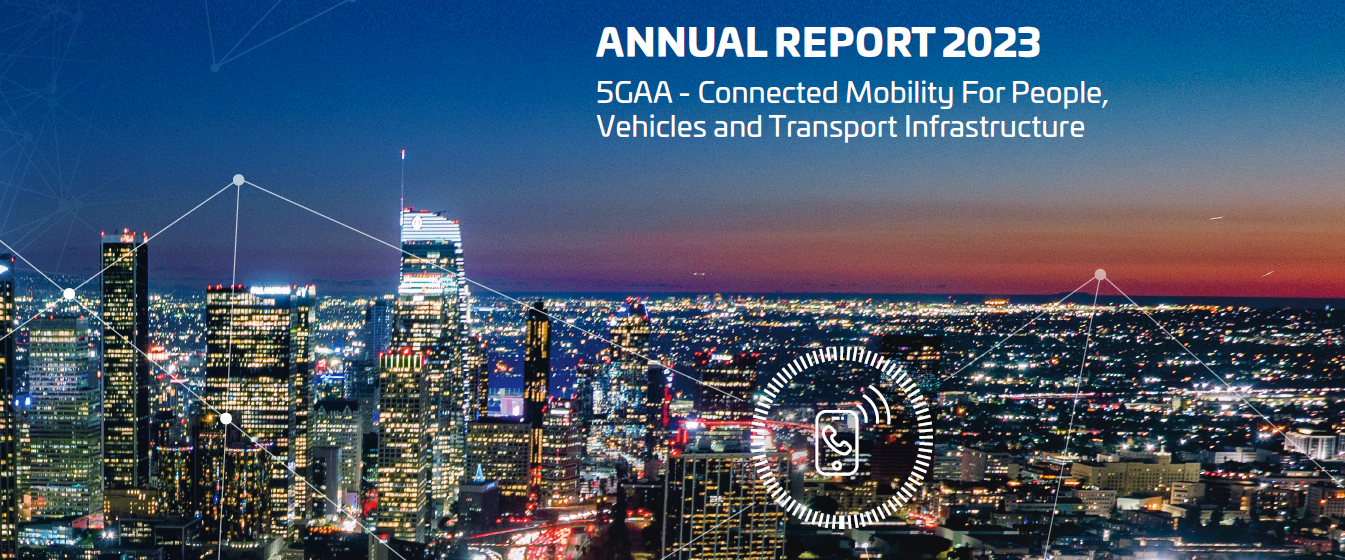
5GAA Annual Report Charts Global Path for C-V2X Deployment
The 5G Automotive Association has released its annual report for 2023, highlighting significant strides made towards global deployment of cellular vehicle-to-everything (C-V2X) technology and connected mobility solutions. The report details the association’s achievements across key areas, all working towards a more connected and automated transportation ecosystem.
Strong Membership and Global Reach
5GAA grew to 126 members in 2023, including leading names from the automotive (11 out of the top 15 carmakers), mobile network operator (8 out of the top 10 MNOs), and smartphone vendor industries (2 top vendors). This diverse membership fosters strong cross-industry collaboration with a global footprint.
Beyond membership, 5GAA actively maintained partnerships with over 40 organisations, including standards development organisations, public administrations, and certification bodies. Notably, 2023 saw the signing of a cooperation agreement with ITS America and renewed Memoranda of Understanding with ITS Korea and 5G Forum.
Recognising the varying pace of V2X deployment across regions, 5GAA continued to expand its reach. In addition to existing regional regulatory-focused sub-groups, a dedicated taskforce was established for India, a promising V2X market. The association also continued to advocate for a scalable and federated approach to managing road traffic information.
Contributing to Standards
Standardisation has been a core focus of the 5GAA since its early days. In 2023, the association and its members participated in 3GPP Release-19 discussions, providing critical automotive industry input as a Market Representation Partner (MRP). This cooperation aims to ensure that C-V2X technology development aligns with global needs. Additionally, 5GAA contributed to regional standardisation efforts by giving input to bodies like ETSI, SAE, and C-SAE.
In Conversation with Policymakers
The association actively engages with policymakers and regulatory bodies around the world. In Europe, 5GAA issued a joint statement with leading European carmakers urging the deployment of 5G-V2X technology in Europe. The association also welcomed positive developments such as FCC waivers for C-V2X deployment in the US, Korea’s selection of C-V2X direct communication as its technology of choice, and Japan’s consideration of using the upper 30 MHz in the 5.9 GHz band for V2X direct communications.
These engagements play a vital role in establishing sufficient regulatory support for the mass adoption of C-V2X technology.
Two Succesful Workshops
Throughout 2023, 5GAA hosted workshops with key stakeholders to identify challenges and advance technology innovation. In The Hague, Netherlands, a workshop focused on C-V2X mass market deployment in real-life traffic. Similarly, a high-level conference, “The Future of Connected Mobility in South Korea,” was held in Seoul. Discussions centered on how connected mobility and ITS can advance road safety and automated driving in the Korean transport ecosystem.
Technical Progress
In 2023, 5GAA maintained a strong work program. The association successfully completed 12 work items, launched 28 new ones for development in 2024, and published 18 technical reports. Key areas of focus included Day 1 V2X services, Automated Valet Parking (AVP) solutions, and interoperability testing for Vulnerable Road User (VRU) protection, with a series of live demonstrations in Mcity, Michigan.
Looking Ahead
5GAA has developed a solid strategic roadmap for its activities in 2024. Over the next months, the association will focus on:
- Prioritising the execution and implementation of readily available or “Day 1” technology and services;
- Accelerating the wide-scale deployment of Day 1 V2X services over mobile network communications;
- Developing an end-to-end AVP service implementation and continuing to advance interoperability among members’ VRUs solutions;
- Tackling technical or political hurdles that prevent the mass roll-out of LTE-V2X direct communications in targeted markets, while laying the groundwork for 5G-V2X direct;
- Chartering a transition path or mitigation measures to ensure continuity of legacy services; and
- Continuing to investigate the potential of emerging technologies like positioning-as-a-service (PaaS), non-terrestrial networks (NTNs), and integrated sensing and communication for V2X applications.
The 5GAA 2023 annual report underscores the association’s vital role in shaping the future of mobility. By fostering collaboration amongst key stakeholders and driving industry progress, 5GAA paves the way for a safer, more efficient, and automated transportation ecosystem.
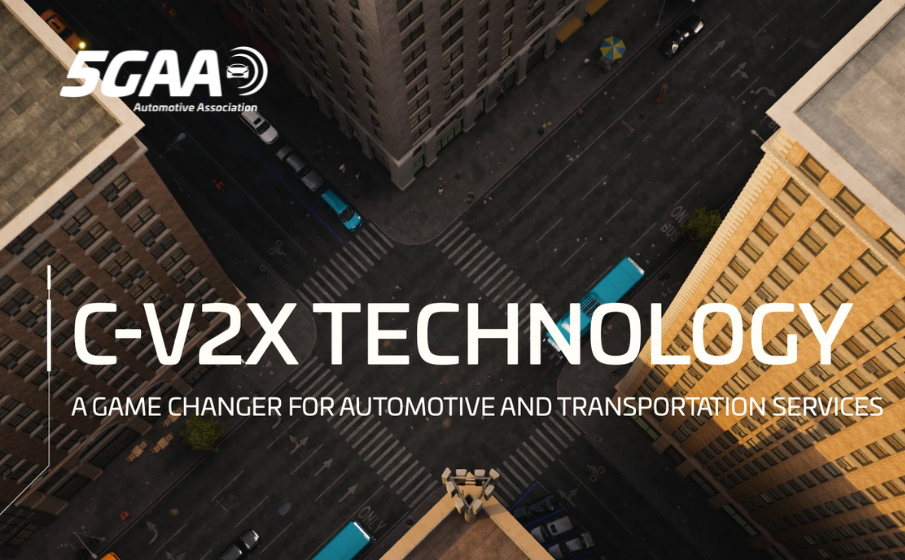
Real-world use cases demonstrate game-changing C-V2X technology
Cellular vehicle-to-everything (C-V2X) technology is a game-changer for automotive and transportation safety and services, helping to make mobility smarter, safer and more sustainable for all road users, including pedestrians.
C-V2X relies on both mobile and direct communications to enable seamless communication between vehicles, road infrastructure, and other road users, unlocking a wide range of life-saving, fuel-saving and time-saving applications. From real-time collision warnings and lane merge assistance to enhanced traffic management, pedestrian safety and automated valet parking, the C-V2X use cases shown in the video demonstrate the transformative power of connected vehicles and road infrastructure. Whether navigating urban environments or cruising along highways or country roads, C-V2X empowers smarter, safer, and more efficient journeys.
Vehicle manufacturers and road and traffic infrastructure managers are already investing in the tech that is turning these visions into reality world-wide.
Uniting the automotive, technology and communications industries in common cause, the 5G Automotive Association (5GAA) is helping to drive the development and deployment of C-V2X technology as it evolves.
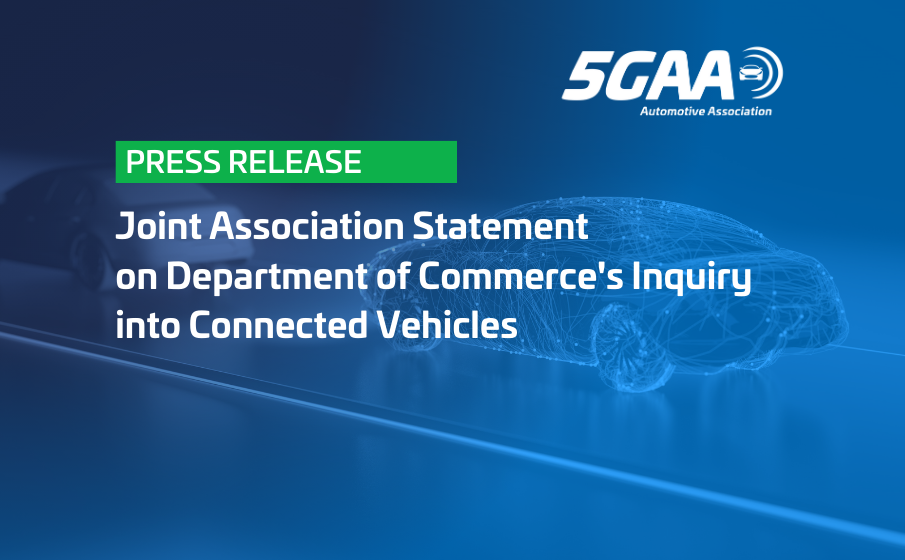
5GAA, Partner Associations Issue Statement on US Department of Commerce’s Inquiry into Connected Vehicles
WASHINGTON D.C., March 7, 2024 – Our organizations, representing the full breadth of the U.S. transportation stakeholder community, fully share the Biden Administration’s commitment to ensuring that connected vehicle technologies operate in a way that is safe and secure, and which protects users’ privacy. We applaud the Department of Commerce and Bureau of Industry and Security for recognizing the many benefits of connected vehicles and noting that its recent Advanced Notice of Proposed Rulemaking does not intend to imply that lifesaving technologies such as vehicle-to-everything (V2X) communications are unsafe for use in the United States. According to the latest estimates from the National Highway Traffic Safety Administration, 42,795 people died in motor vehicle traffic crashes in 2022. We continue to face a national crisis of traffic deaths on U.S. roadways, and we firmly believe that V2X technologies, which allow communication between vehicles, infrastructure, and other road users including pedestrians and bicyclists, can dramatically reduce crashes and resulting fatalities. V2X technology can also help advance climate and sustainability goals by increasing traffic flow and efficiency. We reaffirm our continued support for the rapid, widespread deployment of V2X technologies.
We note that all V2X systems have been designed from the outset with privacy and security in mind, and that V2X has been deployed for a wide variety of use cases in states across the country without incident. Our members have worked closely with U.S. Department of Transportation (USDOT) for several years to proactively develop a robust message security solution for V2X communications. This collaboration has produced a security system that ensures V2X safety messages contain no personal or equipment-identifying information and that utilizes encryption and certificate management methods to limit data collection and prevent unauthorized vehicle manipulation. Privacy and security are also key pillars of our members’ ongoing collaboration with USDOT on the development of a National V2X Deployment Plan. We also note that the supply chain for connected vehicle technology, including V2X direct, is mature, geographically diverse, and not dependent on any particular region or country.
The United States is currently a leader in V2X innovation, but risks falling behind if the government hampers broadscale deployment. We urge the Department of Commerce to work closely with transportation stakeholders to ensure that any resulting regulations that address national security risks are narrowly tailored to minimize unintended consequences or significantly disrupt industry efforts to deploy lifesaving safety technologies.
We look forward to working collaboratively with all stakeholders on this matter to ensure the safe and effective deployment of V2X technologies.
Participating associations: 5G Automotive Association (5GAA), Institute of Transportation Engineers (ITE), Intelligent Transportation Society of America (ITS America), National Electrical Manufacturers Association (NEMA).
Download the joint statement here.
About 5GAA
The 5G Automotive Association (5GAA) is a global, cross-industry organization of over 120 members, including leading global automakers, Tier-1 suppliers, mobile operators, semiconductor companies, and test equipment vendors. 5GAA members work together to develop end-to-end solutions for future mobility and transport services. 5GAA is committed to helping define and develop the next generation of connected mobility, automated vehicles, and intelligent transport solutions based on C-V2X. For more information, visit our website.
Media Contact
John F. Kwant
Executive Director, Americas, 5GAA
john.kwant@5gaa.org

5GAA Fosters Automotive Connectivity Solutions at MWC Barcelona 2024
The 5G Automotive Association (5GAA) is gearing up for the highly anticipated Mobile World Congress (MWC) Barcelona 2024, scheduled from February 26 to 29 at Fira Gran Via.
As a premier event for the mobile industry, MWC serves as a platform for showcasing ground-breaking advancements in cellular-based applications, particularly within the automotive sector. At this year’s event, 5GAA members will unveil innovations driving vehicle connectivity to unprecedented levels — from Non Terrestrial Networks (NTNs) to 5G-V2X communications or VRU protection at scale.
Attendees are invited to visit 5GAA at Hall 6, Stand 6E12, to hear first-hand about the role of our association and membership in revolutionising the mobility landscape.
In a bid to foster deeper understanding about our members’ activities, 5GAA extends an exclusive invitation to journalists to participate in a press tour. This tour, guided by 5GAA CTO Maxime Flament, offers an exclusive behind-the-scenes look into the technologies and initiatives spearheaded by 5GAA member companies. Participants will have the opportunity to exchange with representatives from Deutsche Telekom, Harman, Vodafone, Qualcomm, Autotalks, Keysight, Rohde & Schwarz, DEKRA and Mediatek. Journalists interested in joining the tour are encouraged to secure their spots by direct messaging the organisation or registering here.
Moreover, 5GAA is committed to facilitating meaningful discussions and collaborations during the event. For those seeking to explore the association’s vision and strategies in greater detail, opportunities are available to schedule a meeting with Chief Technology Officer, Maxime Flament.
Additionally, Mr Flament will be participating as a speaker in several sessions:
- ‘Enablement for Connected Vehicles Workshop’, for a panel on ‘New Use Cases and Tech Trends’, on February 28 from 9:50.
- ‘Satellite and Non Terrestrial Networks Summit’, together with 5GAA partner the European Space Agency, on February 28 from 15:15.
- ‘Global 5G Alliances Summit’, a closed-door event hosted by the GSMA APAC 5G Industry Community on February 29.
For further information and inquiries, interested parties are invited to contact 5GAA via email at marcom@5gaa.org.


